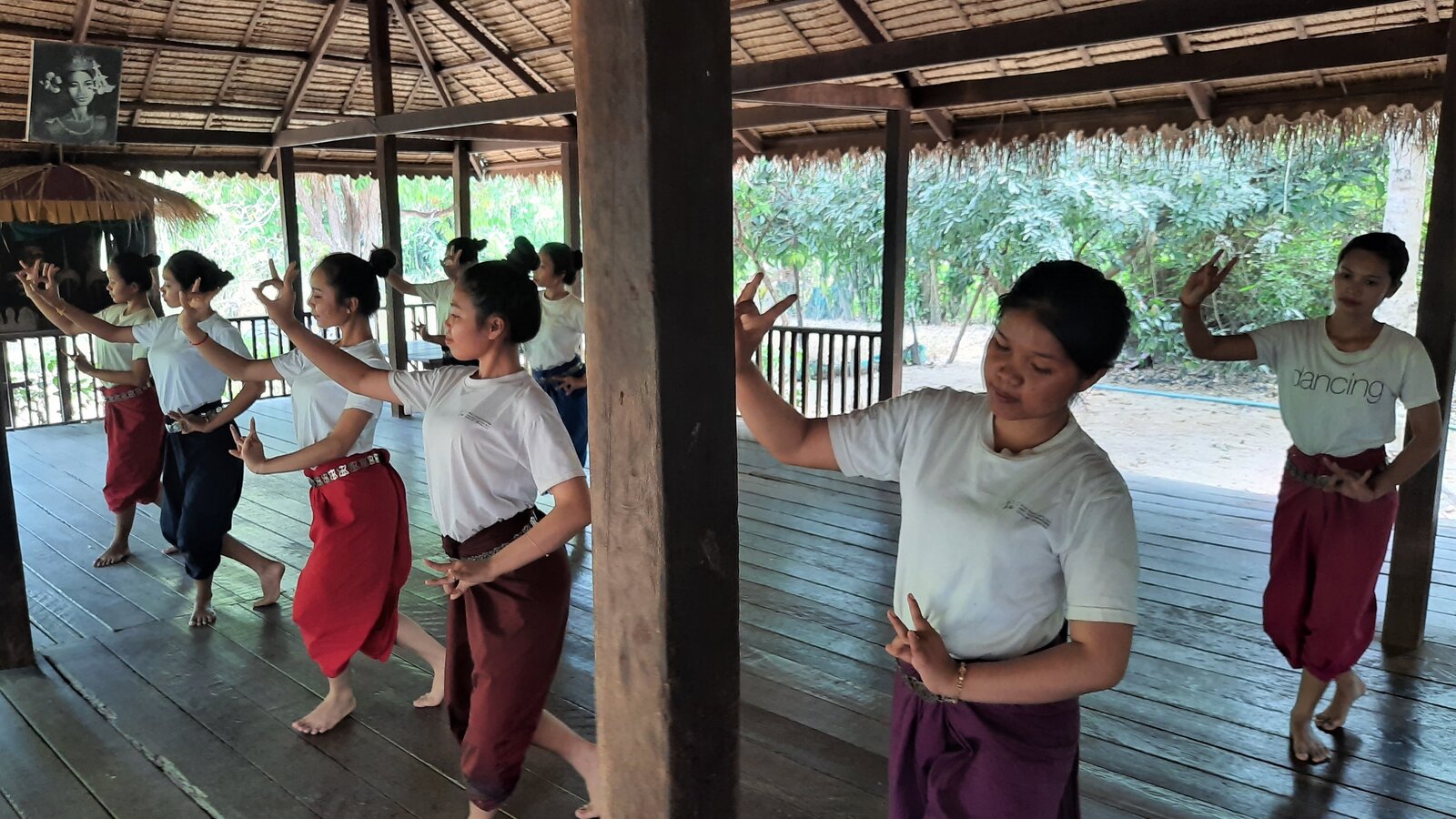
We are in timeless Cambodian countryside, amongst mango and cashew orchards, humble villages, silent remains of the primal forest that once spread freely as far as the eye can see. Yet this place also holds a particularly meaningful status in the Khmer history and culture, near the exquisite Banteay Srei (Women's Citadel) temple, with Phnom Dei topped by a 8th century wat (pagoda) and the even higher Kulen Mountain Range in the background.
"Can you feel the vibe of the land?", asks Ravynn Karet Coxen, founder and "progenitor" of the Ngin Karet Foundation for Cambodia (NKFC) and its school-conservatoire of Khmer classical dance and music; "this quadrant, delimited by Kulen, Kbal Spean, Phnom Dei and Banteay Srei, concentrates the energy of Khmer spirituality. This is a sacred perimeter inhabited by modest, hardworking farmers, monks and nuns".
And now, early afternoon, two dozens of daughters and sons of these same farmers start gathering in the airy sala (pavilion), a traditional wooden structure where they're going to practice like they do five days a week. Most of them are students since the establishment of the school thirteen years ago. All of them are in their teen years.
As everyday, the session starts with a group meditation and prayer in front of the altar where the tiaras and masks are kept, under a black-and-white portrait of a Princess Norodom Buppha Devi at the same age, more or less, when she was initiated to the art of the Cambodian Royal dance by her grand-mother, Queen Kossamak.




Despite the discipline of an ancestral choreography, the precise rendition of every single kbach (hand gesture) or musical phrase, nothing seems forced, contrived. During the pauses, students gayly chat with the dance and music teachers. This is an enthralling mix of youthful energy and extreme concentration. A serene sense of the sacred.
"Almost all of the current 26 students, boys and girls, have done spiritual retreats at the pagoda nearby", notes Ravynn Karet Coxen. A former dancer herself, she has over the years developed a version of the Khmer classical dance as a ritual more than as a merely entertaining performance. Hence the name of the Banteay Srei dance group, Sacred Dancers of Angkor.
This last month only, the group has performed three different buong suong, a ritual dance aimed at channeling the protection of gods and local spirits upon the Kingdom and its inhabitants. In the perimeter of Banteay Srei temple -- a privilege bestowed by the King to the Sacred Dancers --, in the wilderness of the Bamboo Forest on the slopes of the Kulen, at a Siem Reap pagoda for Meak Bochea, the festival commemorating the last sermon given by Buddha...




What also sets the NKFC dance company apart is how the project was linked from the start to a comprehensive Rural Development Program which has benefited 14 villages in the area since 1999. While access to classical Khmer dance has been mostly limited to the daughters and sons of influential families, the Sacred Dancers of Cambodia are youngsters of humble extraction.
"This particular aspect has always endeared the Princess [Buppha Devi] towards us, and she loved to visit the Conservatoire, to share her invaluable knowledge with our wild-eyed country girls who respected her as a beloved godmother and an immense source of inspiration" remarks Ravynn Karet Coxen.
In Phnom Penh, far away from this serene setting, the future of the Royal Ballet of Cambodia, after the Princess' passing last November, rises some palpable anxiety: not only she played a crucial role in the rebirth of the Ballet after the civil war, she also created a new choreographic and artistic language within the frame of the royal tradition.
"The Princess, as the embodiment of the Royal Ballet appointed by Her Grand Mother Queen Kossomak to unveil to the world the mystery and beauty of most sacred repertoires, is irreplaceable, yet the Royal Ballet will go on," reflects Ravynn Karet Coxen.
Then, looking pensively around the tranquil gardens surrounding the dance pavilion, she muses: "How appropriate, how consistent it would be to erect a stupa [funerary monument] to her memory right here, with some of her relics. This way, she'd receive the chants, incantations and vibrations of the prayers, meditation and Pin Peat music that was all her essence, alongside the daily offerings from dancers and musicians she had followed since their entries thirteen years ago, she would listen to the music and prayers which has been with her all her life..."

More about Sacred Dancers of Angkor and NKFC Conservatoire
- Public performances at Divine Sala in Siem Reap every Wednesday and Sunday, 7-8 pm. More information here.
- Visits to the Banteay Srei Conservatoire can be organized by appointment only. Phone +855 63 964 412 /+855 12 772 641, or by email here.
- Donations for a Princess Norodom Buppha Devi Stupa at NKFC Conservatoire are welcome. Inquiries here.



